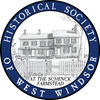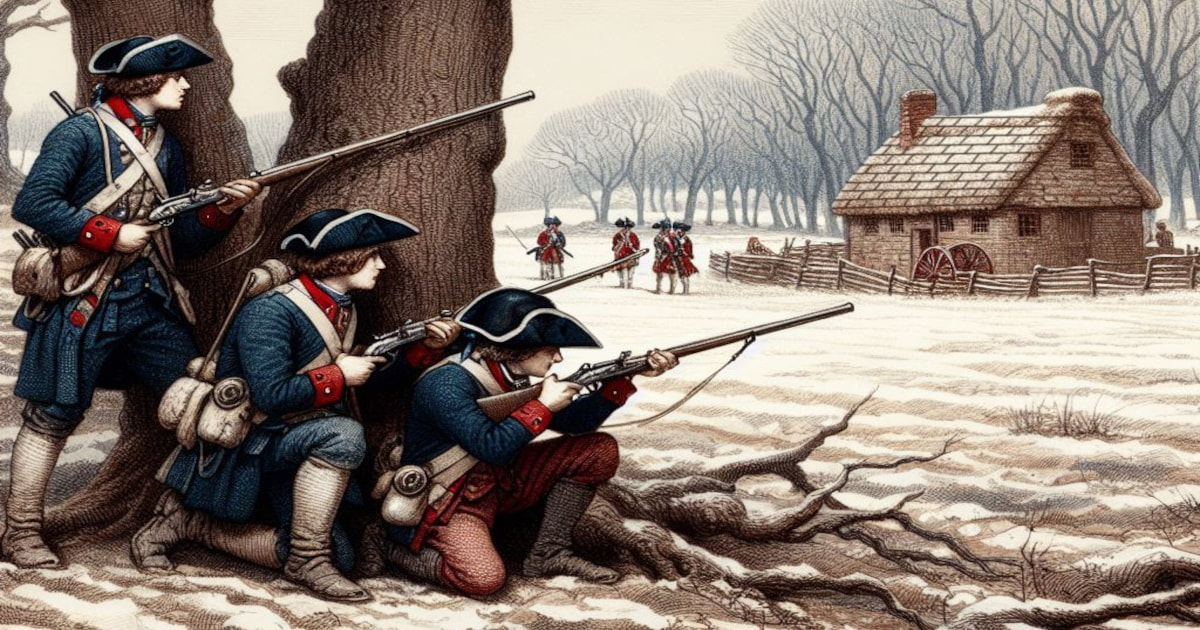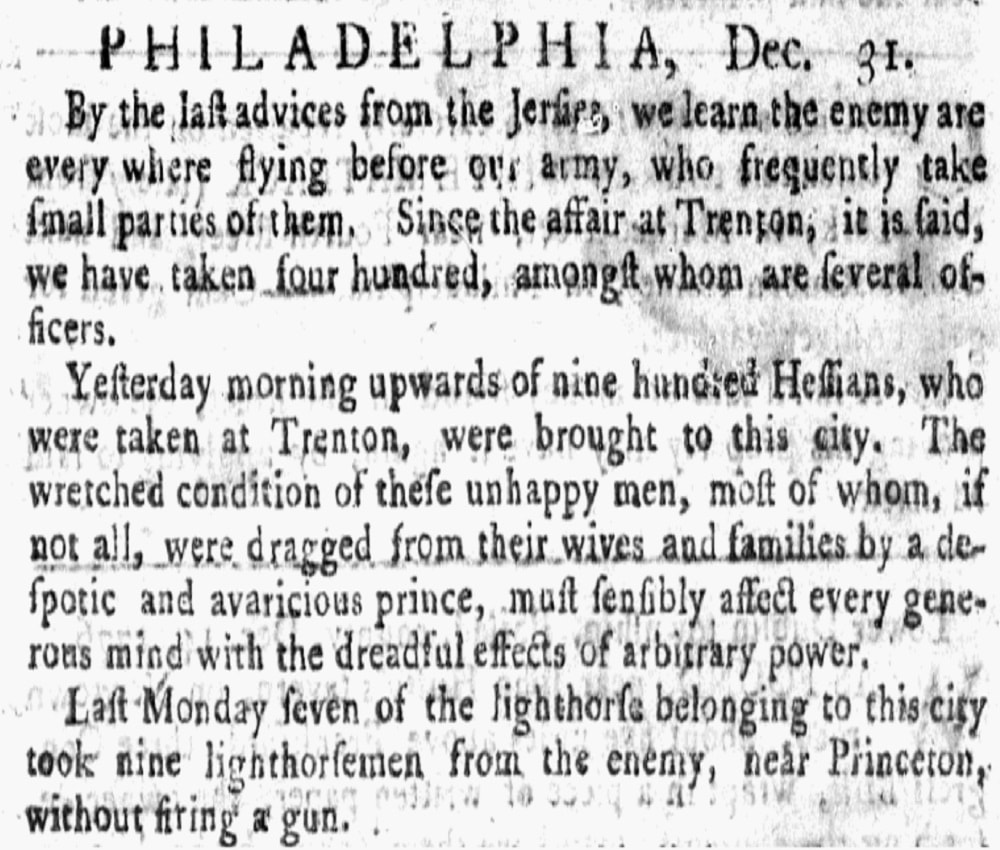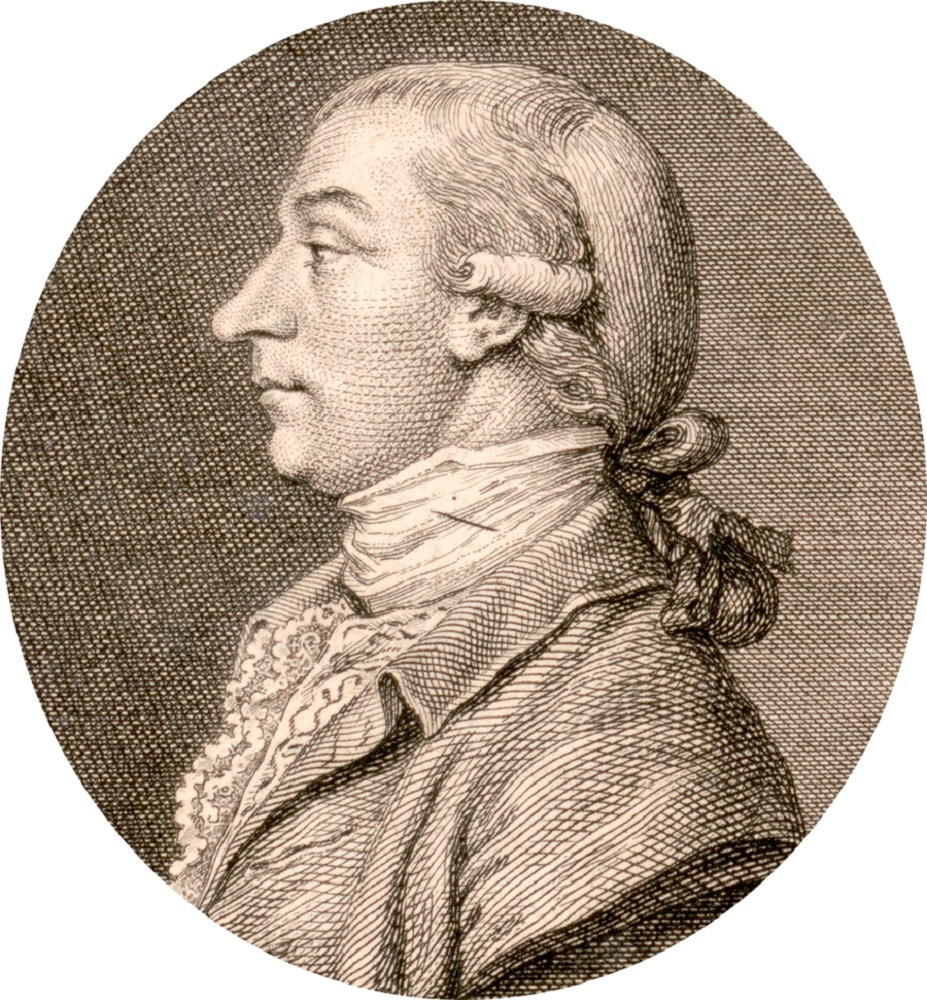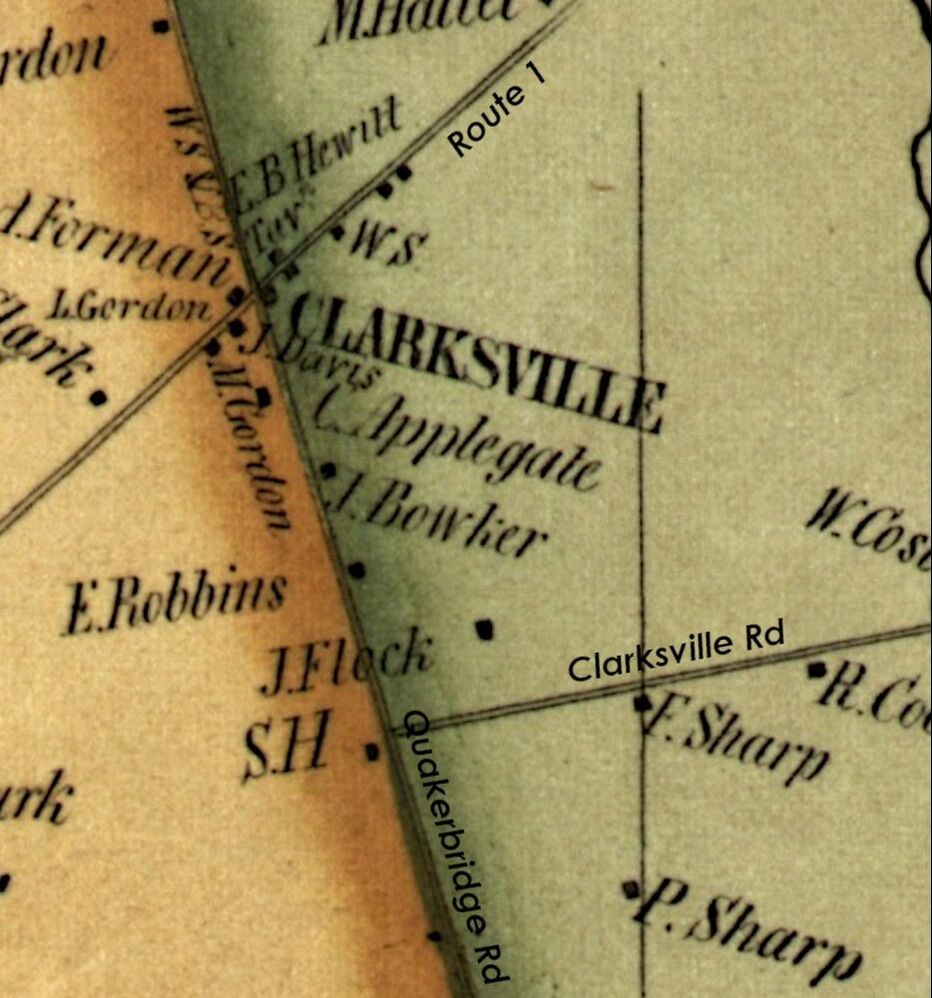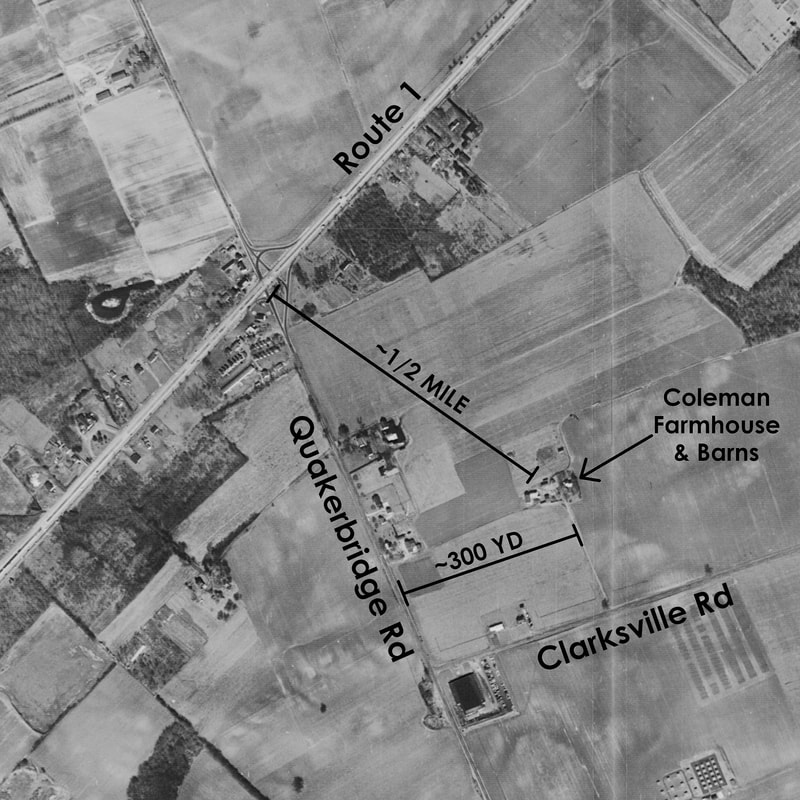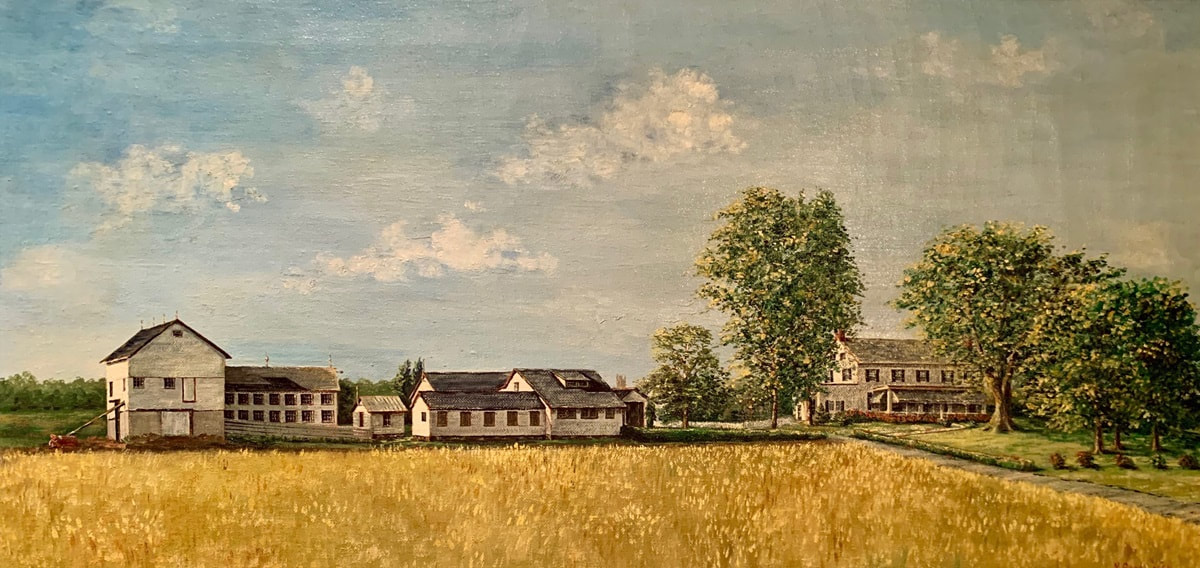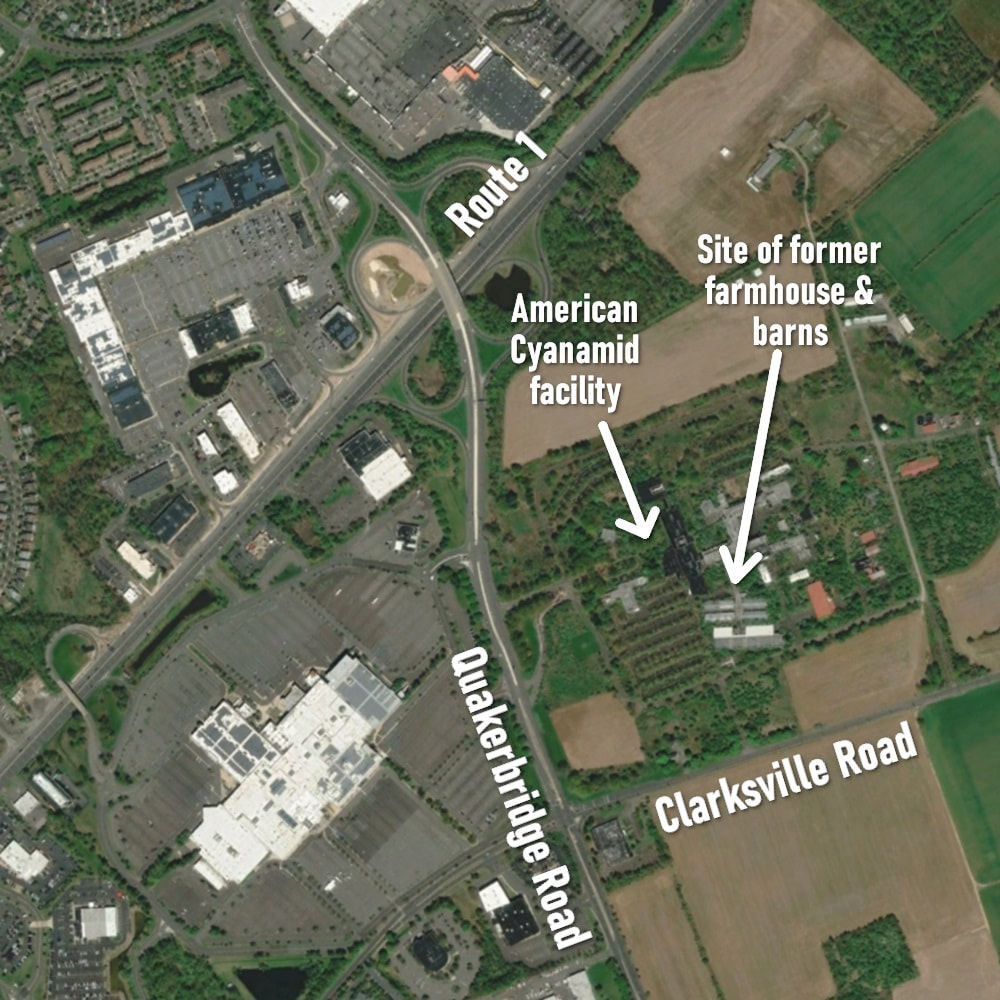A Revolutionary Capture
In December 1776, the Revolutionary War was looking bleak. After months of defeats, many soldiers, with contracts expiring at year's end, were set to resign - and thus possibly cost General George Washington the war. However, three victories in Princeton and Trenton helped turn the tide and save the Revolution. Two of these victories were greatly aided by a capture of British troops in present-day West Windsor.
Historical Overview
|
The year 1776 was riddled with defeats for George Washington. Repeated British triumphs over several months had forced his army south, and a significant portion of his demoralized troops were set to desert him, with their contracts to expire at years'-end. Thus, Washington was in desperate need of victories.
Triumph finally began on December 26, 1776, when the Americans crossed the Delaware River and defeated Hessian auxiliaries at the Battle of Trenton. This - the first of three significant battles in the "Ten Crucial Days" spanning December 25 to January 3 - helped convince many of his men to renew their contracts. However, overall defeat was still very possible, for Washington knew little about the enemy's troop movements and size in the broader central New Jersey area, which risked him losing the next battle and making his victory at Trenton look like an anomaly. Thus, now encamped in Trenton, and letting his troops rest and regroup, Washington required intel to make his next move.[1] Fortunately, he would get it. On December 30, Washington dispatched a small party of between seven and twelve scouts, led by Colonel Joseph Reed, to scope out the approach to Princeton.[2] In 1818, one of the scouts, Thomas Peters, recalled finding what Washington needed: |
"We found that [the British] ... were at Princeton, on their way to Trenton. We advanced ... near to them to gain information ... Observing a foraging party ... we waited until they had passed. Some ... entered a new stone house to plunder it. We immediately rushed on them ...[and]... compelled them to surrender ... It gave Gen. Washington considerable satisfaction to obtain the information he wished..."[3]
|
In an 1816 memoir, Brigadier General James Wilkinson (later the Senior Officer of the U.S. Army) recounted the same capture:
Colonel Joseph Reed, with a reconnoitering party of twelve dragoons, was sent out to inquire for the enemy ... he surprised a commissary and foraging party ... whom he charged and made prisoners without the loss of a man, and ... returned with every trooper his prisoner ... This little act of decisive gallantry ..., [boosted] the confidence of the troops and certainly reflected high [honor] on the small detachment* ... The information received from the prisoners ... left no doubt of the enemy's superiority, and his intention to advance upon us, which would put General Washington in a critical situation. |
|
Joseph Reed (himself later a Founding Father of the United States) also wrote about the incident:
We met with little success on our way, or in the immediate vicinity of Princeton, to which we had approached within three miles. The ravages of the enemy had struck such terror that no rewards would tempt the inhabitants ... to go into Princeton on this errand ... But ... as we were passing ... almost within view of the town, a British soldier was observed passing from a barn to the dwelling-house without arms ... Two of our party were sent to bring him in, but ... another was seen, and then a third, when orders were given for our whole party to charge ... Twelve British soldiers, equipped as dragoons, and well-armed, their pieces loaded, and having the advantage of the house, surrendered to seven horsemen, six of whom had never before seen an enemy. The sergeant only escaped and reported ... that he had fought his way through fifty horsemen ... A Commissary was also taken ... from them a very perfect account was obtained, that Lord Cornwallis, with a body of picked troops and well appointed, had the day before reinforced General Grant at Princeton, and that they were ... to begin their march the next morning to dislodge us from Trenton, their whole force being not less than seven or eight thousand men."[5] |
|
This intel from these twelve British soldiers - corroborated the next day by a letter sent from American Colonel John Cadwalader in Crosswicks, based off of information provided to him by a spy[6] - revealed British troop size and position in Princeton and also alerted Washington that British General Lord Charles Cornwallis intended to march with thousands of reinforcements to recapture Trenton. With this new information, the Americans were thus able to prepare for and temporarily repeal the enemy when Cornwallis attacked on January 2 at the Second Battle of Trenton (also called the Battle of Assunpink).
The Americans held off the British that day in their second victory of the Ten Crucial Days. However, with his new intel, Washington also knew he was facing superior forces in Trenton while Princeton was simultaneously poorly fortified by the British. Thus, after both armies retreated for the night, he and his council of war ordered his army to secretly depart the city. Soon, soldiers lit fires and a small contingent stayed to fool Cornwallis into believing the Americans were still encamped in Trenton. Unbeknownst to him, however, most of Washington's army was marching north toward Princeton. This Revolutionary March - which passed through present-day West Windsor - took several hours, passing through about 13 miles of woods and farmland. Great care was made to slip out silently, and to mask the plans of what was happening, even to Washington's own soldiers. Onward they trudged, through cold and wind, in the dead of night. |
However, the sun soon literally - and metaphorically - rose, when the Americans engaged with the British at the Battle of Princeton on January 3, 1777, where Washington's troops emerged victorious. For a third time in these Ten Crucial Days, the patriots had proved that the Revolution was not a lost cause. The Battle of Princeton and both Battles of Trenton also convinced many more patriotic soldiers to enlist in the spring, positioned Washington to eventually drive the British out of New Jersey, and more broadly galvanized public support (including eventual French backers) for the patriots. [7]
However, where was this farmhouse, at which Colonel Reed's scouting party captured those twelve British troops who gave such critical information to Washington? In 1847, Joseph's grandson, William, published an account of Joseph's service and pinpointed the property's location:
However, where was this farmhouse, at which Colonel Reed's scouting party captured those twelve British troops who gave such critical information to Washington? In 1847, Joseph's grandson, William, published an account of Joseph's service and pinpointed the property's location:
On the 3rd June 1843, the author was enabled to ascertain with great precision the place where this affair occurred. It was at the house occupied by John Flock, about half a mile southeast of [the West Windsor/Lawrence village of] Clarksville, between four and five miles from Princeton, about 300 yards east of the Quaker Road leading from Stony Brook to Crosswicks ... British parties were billeted at most of the houses about Penn's Neck, but must have withdrawn before the 3d January, or Washington's approach would have been sooner discovered.[8] |
|
While it's currently unknown who lived there in late 1776, the Flock family certainly owned the farm from 1799[9] to 1883.[10] John Flock - the family's patriarch - himself served as a private in the Burlington County militia.[11] See the adjacent maps from 1849, 1959, and 2020 showing the site.[12],[13]
In 1883, The Flocks sold the property to Zephaniah Adams, who owned it until 1898[14],[15] After him was the Coleman family starting.[16] Like the Flocks and Adams, the Colemans farmed this land - that is, until they sold it to a multinational agricultural and industrial chemical conglomerate called "American Cyanamid" in the 1950s.[17] The old stone farmhouse[18] and barns, in which the British troops had been captured, were subsequently demolished and the property, alongside other adjacent tracts, became an agricultural research & development facility.[19],[20],[21] However, the campus shut down in the early 2000s, was demolished in 2022, and at the time of this writing (late 2023) may become a sprawling warehouse complex.[22] Regardless of the site's future, the fact remains that it was the location of a small, yet nationally-influential capture of British troops that played an outsized role in the American Revolution. |
Bibliography
- Kidder, William Larry. Ten Crucial Days: Washington’s Vision for Victory Unfolds. Brentwood, Tennessee: Knox Press, 2020
- Wilkinson, James. Memoirs of my own times. Vol. 1. 3 vols. Philadelphia, Pennsylvania: Printed by Abraham Small, 1816.
- Peters, Thomas. “A Scrap of ‘Troop’ History.” The Pennsylvania Magazine of History and Biography 15, no. 2, 1891. Contains transcription of notes written by Thomas Peters, Revolutionary War soldier, written in 1818, in his copy of the "By-Laws of the First Troop Philadelphia City Cavalry," itself printed in 1815. These notes were donated to the Pennsylvania Magazine of History and Biography by a "Mrs. Roberdeau Buchanan," Peters' granddaughter.
- Wilkinson, James. Memoirs of my own times. Vol. 1. 3 vols. Philadelphia, Pennsylvania: Printed by Abraham Small, 1816.
- Reed, William B. Life and correspondence of Joseph Reed. Philadelphia, Pennsylvania: Lindsay and Blakiston, 1847.
- Ibid.
- Kidder, William Larry. Ten Crucial Days: Washington’s Vision for Victory Unfolds. Brentwood, Tennessee: Knox Press, 2020
- Reed, William B. Life and correspondence of Joseph Reed. Philadelphia, Pennsylvania: Lindsay and Blakiston, 1847.
- Flock, John, Woolley, James. “Indenture.” Windsor, 1799. Located in the New Jersey state Archives, Middlesex County Deed Book 6 Page 250.
- Adams, Zephaniah S., Flock, John T, Flock, Margaret R. “Indenture.” West Windsor, 1883. Located in the Mercer County Clerk's Office, Mercer County Deed Book 136 Page 89.
- “Application for Membership - The New Jersey Society of the National Society Sons of the American Revolution.” Hamilton Township, New Jersey, July 13, 1965. Mervin Tindall Flock's application for membership. Application mentions that Flock served with Burlington Co. militia. Application was approved and registered by Registrar General on July 13, 1965. Application references the Flock family bible, Hamilton Square Graveyard, and the Service of E. Farnsworth.
- Otley, J W, and James Keily. “Map of Mercer County, New Jersey.” Map. Camden, New Jersey: L. Van der Veer, 1849.
- “West Windsor Aerial Photography Composite Map, 1959.” Map. Historical Society of West Windsor - Map Archives. West Windsor, NJ, 1959.
- Adams, Zephaniah S., Flock, John T, Flock, Margaret R. “Indenture.” West Windsor, 1883. Located in the Mercer County Clerk's Office, Mercer County Deed Book 136 Page 89.
- Adams, Rebecca S., Adams, Zephaniah S., Coleman, Herbert J. “Indenture.” West Windsor, 1898. Located in the Mercer County Clerk's Office, Mercer County Deed Book 219 Page 525.
- Ibid.
- "Chemical Plant, Experimental Farm on 1,000-Acre W. Windsor Tract." Trenton Evening Times. March 22, 1957.
- Coleman, Richard. Letter to Trevor LePrevost. Farming in West Windsor, NJ ?Sent Before ?, August 16, 2020. Memoirs of life on the Coleman farm. Trevor LePrevost was Vice President of the Historical Society of West Windsor in 2020. The purpose of this citation is to corroborate the fact that the house that stood on December 30, 1776 at which British troops were captured by Colonel Joseph Reed and his scouting party also stood until the 1950s/60s when it was demolished by American Cyanamid.
- “West Windsor Aerial Photography Composite Map, 1965.” Map. Historical Society of West Windsor - Map Archives. West Windsor, NJ, 1965.
- "Topics of the Town - Agriculture Center Set." Town Topics. January 10, 1960.
- “West Windsor Aerial Photography Composite Map, 2002.” Map. Historical Society of West Windsor - Map Archives. West Windsor, NJ, 2002.
- "West Windsor mayor talks Bridge Point 8 Warehouse Complex Approval." West Windsor and Plainsboro News. March 1, 2023.
